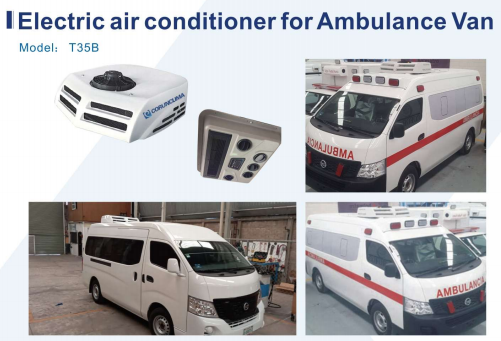The Growing Demand for Electric Ambulance Air Conditioners: Reliability, Comfort, and New Opportunities
As the healthcare and emergency response sectors evolve, the need for reliable, energy-efficient, and environmentally-friendly solutions is becoming more important. This is especially true in the case of ambulance services, where ensuring a comfortable and controlled environment for both patients and medical staff is crucial. With the increasing push for greener technologies, electric ambulance air conditioners are emerging as a pivotal solution to meet these needs, offering significant benefits in terms of reliability, comfort, and business opportunities.

Reliability and Value for Emergency Services
For emergency medical services (EMS), reliability is paramount. Ambulances are often required to operate in demanding conditions, transporting patients in critical situations. The last thing EMS personnel need is a malfunctioning air conditioning system that compromises the comfort and safety of patients or causes operational delays.
Electric ambulance air conditioners are engineered for high reliability, ensuring that critical cooling and air quality systems remain functional even in extreme heat or long shifts. These systems are powered by high-efficiency electric motors and use advanced technology to provide consistent and effective temperature control. This means that air conditioning remains stable regardless of the vehicle's engine operation, enhancing performance during long journeys or at high altitudes.
Unlike traditional engine-powered units, which draw power from the ambulance’s main engine, electric air conditioners operate independently from the vehicle’s engine. This feature significantly reduces fuel consumption, allowing for more efficient energy use and longer operational hours between charges. The result is lower operational costs for ambulance services, which can now allocate more resources to other critical operational needs.
Furthermore, electric air conditioners require less maintenance than their engine-powered counterparts, which typically face wear and tear from long hours of operation. Fewer mechanical parts and simpler cooling mechanisms reduce the risk of breakdowns, offering greater reliability for EMS teams who need equipment that can withstand the pressures of emergency service work.
Comfort and Peace of Mind for Patients and Medical Personnel
In an emergency, ensuring the comfort and well-being of patients is as important as the timely delivery of care. This includes providing a controlled environment that minimizes stress and discomfort during transport, especially for those in critical condition. Electric ambulance air conditioners provide a key benefit in this regard, ensuring a consistent and comfortable cabin temperature regardless of external weather conditions.
For patients, especially those in trauma or with pre-existing conditions, temperature control can play a vital role in preventing further complications. Electric air conditioners can quickly cool down the ambulance’s interior during extreme heat and maintain an optimal environment during transport. For medical staff, who often work long hours in high-stress conditions, having a quiet and cool cabin is also essential for focus and performance. The silent operation of electric air conditioners ensures that medical personnel can communicate effectively and provide the necessary care without the noise distractions often associated with engine-driven systems.
Additionally, electric air conditioners contribute to a cleaner and more healthy environment inside the vehicle. Unlike traditional systems, which produce harmful emissions and pollutants from the engine, electric units run on clean energy, improving air quality inside the cabin and reducing exposure to harmful exhaust fumes.
New Business Opportunities and Industry Collaboration
The rise of electric ambulance air conditioners also creates a range of business opportunities and fosters collaboration within the healthcare and transportation industries. As governments worldwide continue to prioritize sustainability and implement stricter environmental regulations, the adoption of electric-powered equipment is becoming a strategic advantage for service providers.
Many government programs offer financial incentives to organizations that invest in green technologies. These incentives can help offset the initial cost of upgrading to electric ambulance air conditioning systems, making it easier for EMS providers to adopt the technology. Additionally, with the growing focus on electric vehicles (EVs) across various sectors, this shift presents a unique business opportunity for ambulance manufacturers, HVAC system providers, and fleet operators to collaborate on the development of more efficient, eco-friendly, and cost-effective solutions.
Incorporating electric air conditioners in ambulances also supports the larger trend of electrification in the transportation sector. As more EMS fleets transition to electric vehicles, electric ambulance air conditioners will become a vital part of the overall shift toward greener, more sustainable healthcare solutions. This trend encourages partnerships between healthcare organizations, technology providers, and government agencies to drive innovation and improve service delivery.
Furthermore, the adoption of electric ambulance air conditioners aligns with the increasing demand for corporate social responsibility (CSR) within the healthcare sector. By investing in energy-efficient, environmentally-friendly technologies, ambulance services demonstrate their commitment to reducing their environmental impact while delivering high-quality service to patients in need.
Conclusion: A Greener, More Efficient Future for Ambulance Services
The adoption of electric ambulance air conditioners represents a significant step forward in enhancing the reliability, comfort, and efficiency of emergency medical services. By providing reliable and cost-effective solutions that operate independently from the vehicle’s engine, these systems offer significant operational benefits for EMS providers. The comfort of both patients and medical personnel is also greatly improved, thanks to quieter operation and cleaner air, contributing to a better overall healthcare experience.
As the transportation sector continues to electrify, electric ambulance air conditioners will play a crucial role in supporting this transition, opening the door to new business opportunities and fostering collaborations across industries. By adopting this technology, EMS providers not only improve their operations but also contribute to a more sustainable and responsible healthcare system, ensuring that they are well-positioned to meet the demands of the future.
